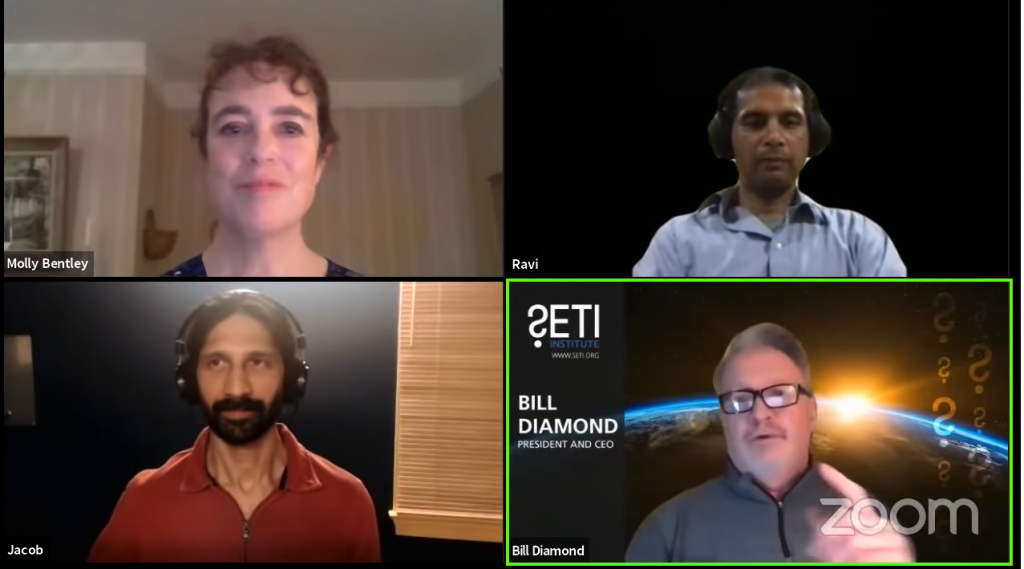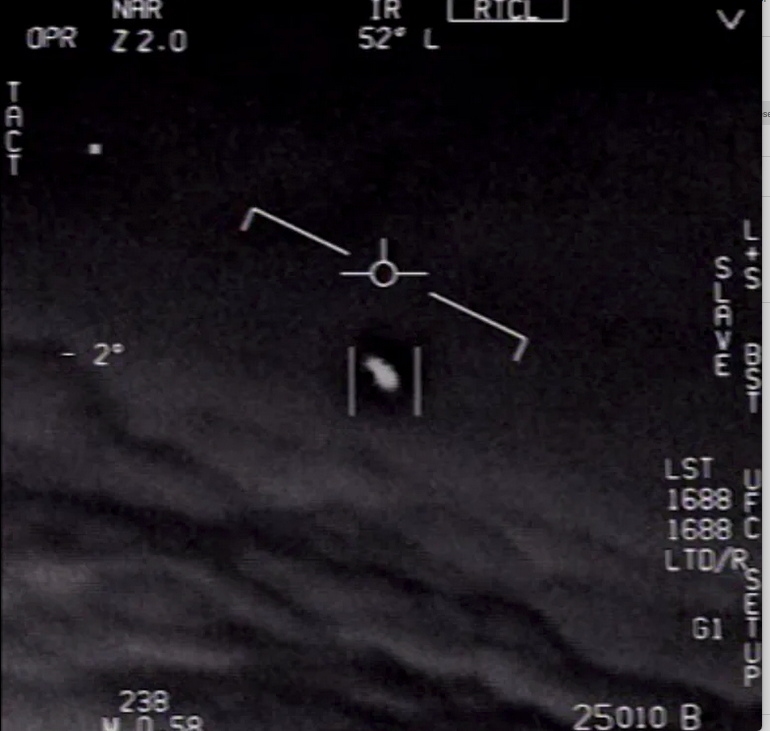by Carl Kruse
The Carl Kruse Blog sponsored a 17 November 2021 discussion organized by the SETI Institute on whether UAPs, commonly called UFOs, deserved more attention from the scientific community. Hazel Anna Rogers, a regular contributor to our blog, took in the chat and then summarized her impressions of what transpired. Here is Hazel’s take. The full discussion can be viewed at the SETI Institute’s YouTube channel here. – Carl Kruse
==============
The scene is set.
Four faces face their cameras, ready for the discussion to begin. They are the faces of Dr. Jacob Haqq Misra, SETI astronomer and senior research investigator at the Blue Marble Space Institute of Science, Dr. Ravi Kopparapu, planetary scientist and an astrophysicist at NASA Goddard Space Flight Center, Molly Bentley, host and producer of Big Picture Science who will be moderating the conversation, and, finally, Bill Diamond, President and CEO of the SETI Institute of Mountview, California, which is hosting this talk.
Bill Diamond introduces the audience to the topic of discussion.
‘Roswell, New Mexico, June-July 1947. Did a flying disc or UAP land on the Roswell ranch, or was it a weather balloon, as the US Army reported it to be? Was there a biological alien on board, and did the government cover up the evidence?’
The July 8, 1947 headline in a Roswell newspaper that got everything going.
UAPs are Unidentified Aerial Phenomena. The study of these objects is still heavily stigmatized within the scientific community, and the guests present are here to talk about why UAPs deserve scientific attention and why the taboo surrounding such research should be collapsed once and for all.
Guests Dr Haqq-Misra and Dr Kopparapu co-wrote two articles, one in Scientific American published in July 2020 and another in the Washington Post in June 2021 advocating for a scientific investigation into UAPs by interdisciplinary teams of scientists. These two men are quick to emphasize that neither the federal government or the scientific community have investigated or studied these phenomena in a methodical manner at any point during the twenty-first century.
This talk is sponsored by Carl Kruse, who grew up in Puerto Rico frequently visiting the Arecibo Radio Telescope there, and, since taking a SETI course in the 90s, has been supporting the non-profit organization.
Once Diamond has disappeared from the screen, the real talking begins.
Bentley offers us some context with regards to the New York Times publication at the end of 2017 which suggested that the US government had a secret UFO program. In even more recent times, the Department of Defense released three navy videos from a once ‘classified’ government program. These images revealed objects zipping through the sky at high speeds. These phenomena have not, as of yet, been recognized as human objects or objects that could have been manufactured on earth.
In June of this year, the UAP task force released 144 sightings by the military, one of which was explained by The Pentagon as a balloon. The other 143 have not been explained.
Haqq-Misra, in response to Bentley’s question about the ‘non-human’ characteristics of these particular UAP sightings, suggests that their rapid movement is very puzzling in that they present acceleration that defies gravity (and which our own human pilots wouldn’t survive), and that the amount of energy required to generate such speed is greater than what we could produce on earth. Haqq-Misra proposes that there are in fact enough snippets of data to merit an investigation into these objects, if only into the physics of their rapid movement.
Bentley asks another question, one that may well be on many of our minds:
‘How do we know that these images of so-called UAPs are not just ‘quirks’ of the instruments used to capture them?’
To this Kopparapu, humbly, indicates that it is indeed possible that these sighting could be sensor errors, but that the images would require more analysis before reaching this conclusion. The issue is that these UAPs are not one singular type of object moving in a predictable way – they are all unique in their qualities, thus meriting completely different investigations and approaches. These questions about the phenomena being ‘glitches’ as such is not a new thing, Kopparapu continues; Professor James Macdonald, in his science and default document, wrote about 4 cases that could be explained by instrumental issues. Kopparapu urges us to recognise and try to understand our biases towards the history of UAPs, and to embrace these new investigations with an open mind.
But, you might be wondering, these objects have already been studied by the Pentagon – what more can scientists learn that hasn’t already been done?
Haqq-Misra has a simple but effective response to this question: ‘I want to know what they are!’
He continues to explain that conversations do often focus on the ‘what’ of UAPs, but that we also need to ask ‘how’ we can understand ‘what’ they are. We have multiple pieces of data that suggest that these ARE in fact objects. Haqq-Misra propounds that, in any other field of science, such data would be pursued emphatically. Furthermore, if all of these UAPs fall in the category of birds or airplanes or balloons, then why do we have such a hard time identifying them?
Food for thought, certainly. But what could Haqq-Misra and Kopparapu achieve that the government could not?
Well, most of the government data is still classified, so scientists can’t rely on that data to find answers. In order to get past this issue of ‘classified’ data you need to produce your OWN data. Interesting and potentially important data could also be acquired from NASA and other public organizations to supplement any new data that scientists acquire through methodical investigation. These kind of investigations have been attempted in the past in such projects as the 1966-68 Condon Report and Projects Sign, Grudge, and Blue Book in the 1940s and 50s respectively.
Haqq-Misra and Kopparapu are both quick to highlight that, in the past, it was okay to speak openly about conducting scientific investigations into these objects, and that we need this kind of debate today as it is what enables science to progress on a global scale. We must discuss this science, move away from the pseudo-scientific UFO arena, collect the data, and see what we might learn about these objects. Haqq-Misra argues that the taboo around UAPs comes from guilt by association; people might hear the word ‘UFO’ and think of flying saucers and little green men and abductions. He states that, prior to Covid, he went to view Carl Sagan’s files in the Library of Congress, which included several files on UFOs as well as crop circles. Being open enough to embrace and research what Carl had collected, Haqq-Misra says, means separating it from the ‘paranormal’ and the pseudo-scientific paranormal content which most scientists would prefer to disassociate themselves from.
Bentley continues on this subject, stating that crop circles were debunked through methodical investigation, and further that the government changed the common term UFO to UAP in order to remove the stigma around pilots coming forwards about things they might have seen. Bentley repeats that both scientists are NOT invested in looking at these objects as ‘alien crafts’, and instead that they wish to decouple the idea of aliens from actual scientific investigation into what these UAPs are, the conclusion of which is not necessarily ‘alien’. It is simply ‘WHAT are they?’.
A 2009 crop circle in a Whiltshire wheat field is pretty but not the work of aliens.
Photo: the Smithsonian.
Kopparapu goes on to compare the initial study of UAPs to the initial study of astronomical phenomena such as gamma-ray bursts or supernovae or gravitational waves with regards to the transient nature of these phenomena and how scientists study them. He states there is indeed a precedent about how scientists conduct these investigations, for example using particular instruments and methods with which to collaborate and collect new data. Kopparapu says:
‘If I see a bright shiny object in the sky and I choose not to share that data then I further the taboo. If we do not study these phenomena, then we will never progress, and thus we will never understand them. Maybe all UAPs will end up mundane and nothing special. But we should investigate them scientifically to understand them, rather than speculating.
He continues:
‘Our approach is agnostic, so we’re open to everything. If they’re all strange balloons, then I’m still happy!’
The scientific disciplines that Kopparapu suggests might be useful to deploy would be aviation and aerospace experts, meteorologists, and physical scientists, and that the investigations would be conducted on a worldwide scale. He proposes that fast tracking cameras, infrared cameras, telescopes, and radio would be useful to register different wavelengths that might lead scientists to finding more out about UAPs. Haqq-Misra proceeds this by commenting that, with the limited funding that they are likely to acquire, global coverage (to some capacity) and ground observation would be very useful. He also notes that the government says they would embrace more intergovernmental sharing of data, and that the universal sharing and collecting of data with lots of different non-governmental organisations would be instrumental in going forwards with the investigation of UAPs. Both Kopparapu and Haqq-Misra denounce the idea of basing an investigation on eye-witness accounts rather than concrete physical data, but they are open to conducting oral investigations in order to establish where they could conduct further studies.
Bentley then asks the scientists about narrowing the search, and proposes herself that, often, these objects are sighted from the air, over water, and near military compounds. Kopparapu debunks this comment, arguing that the idea that the objects are always near military complexes is a bias created from the fact that this is just where some of the PUBLISHED sightings have been.
Referring to the taboo of studying UAPs, Bentley asks the scientists to give examples of scientific studies that were taboo but which were pursued and concluded. Haqq-Misra uses the example of endosymbiosis, and Kopparapu that of plate tectonics. They agree that UAPs seem to be worth studying but that it isn’t actually necessary to have a theoretical understanding of UAPs in order to study them, just as, with plate tectonics, Alfred Wegner argued the case for continental drift without having all of the relevant data or understanding from which to hypothesise.
Kopparapu and Bentley begin debating about speculation with regards to UAPs. Bentley mentions that, recently, The Pentagon had published that China surprised them by testing a hypersonic missile (China’s so-called ‘sputnik’ moment). Bentley is of the opinion that the way the missile was described as moving seems to her to be similar to the movements of the some of the UAPs (zigzagging and sudden changes of course), and that the complexity of these objects would potentially render US defences obsolete. She argues that these missiles have NOT been connected to the UAP report, and asks whether it might be possible that the answers for questions we have about UAPs might be right in front of us. Kopparapu retorts by stating that the idea that these objects are from different nations is not an explanation for every single kind of UAP, and that there are far too many cases to put a blanket explanation, such as the hypersonic missile, on them.
Here are a few interesting questions which were asked at the end of the discussion by the public:
- What is the protocol for public release if the UAPs are confirmed as extra-terrestrial?
Haqq-Misra: If it’s the government then we have no control. If it’s scientists doing the work, then if we did find something extra-terrestrial, we’d try our best to corroborate our explanations and then we’d need to responsibly spread this information.
- How much money is needed to fund an ideal surveillance network?
Haqq-Misra: Hundreds of millions or billions of dollars.
- How can we train our observational systems and sensors to recognise unknown crafts or objects entering our atmosphere?
Kopparapu: There are a lot of things that are entering and leaving our atmosphere, such as noise. We need good algorithms that filter our the ‘noise’. To do that we need to have good analysis methods and algorithms that can be trained, for example Artificial Intelligence.
- How do you filter our ‘natural’ phenomena from ‘non’ natural?
Kopparapu: We can rule out the objects that we understand, those that are ‘known’ as such. We also cannot say that we have ‘found’ something definitely. We can only say that we’ve noticed something ‘interesting’. Some of the objects in the released sightings do look like astronomical phenomena, and we would filter those out from our investigation.
- In what way would the study of UAPs set a precedent for scientific endeavours?
Haqq-Misra: We don’t become scientists because we know everything. We want to learn and find things out and so when something is anomalous then it should get scientists excited to try and understand it. There needs to be a humility in science in that we may have to change or shift our models and realise that we are sometimes wrong. This humility needs to be at the core of everything we do. We don’t want to arrive at the top of the mountain and say ‘well I’m done now’. We need to reject this kind of hubris.
Kopparapu: Scientists are understandably sceptical. However, the processes towards finally discovering something concrete about UAPs have been partially conducted before and we will continue from there. We need criticism in science, and we will welcome it.
- What would be exciting/personally important to you to discover?
Kopparapu: I have to be careful here because I dislike speculation of this kind. Anything that follows a scientific method and what comes out of those methods would make me excited. I want to be excited for the right reasons. Having an answer would excite me if it was an answer acquired by scientific investigation. Aliens would definitely excite me. A lot.
Haqq-Misra: This topic drew me in BECAUSE it is taboo. You can’t tell me that I’m not allowed to study something if I find it interesting. I would be happy if 10 or 20 years from now if a scientist could have investigative interests in UAPs and it not be frowned upon. I would be happy with that. If there really is unknown physics that we don’t understand then I’m really excited to learn something new about physics too! I don’t even care what the source is. Of course, I’d be excited by aliens but if anything can teach us new physics that would be really cool. This is something we don’t understand, and if these are all balloons then that is STILL important. If we are misidentifying this many objects that than is an issue too.
- What can the public do to contribute to your efforts?
Haqq-Misra: There are bills proposed in the senate to pursue these investigations. The senate is interested. Tell your congress people that you are interested in UAP studies. Separate this from the pseudo-scientific. Make it rational and appealing.
Bill Diamond returns at the end of the conversation. His final words are encouraging, and a perfect end to what has been a riveting discussion:
‘Curiosity brings us together. Wherever we are from, we share this curiosity and that is what is so fantastic. How wonderful that we have such a global audience with us tonight. Thank you to everyone for coming, and thank you to Carl Kruse and the numerous others that support the SETI Institute.’
==========================
The Carl Kruse Nonprofits Blog is at https://carlkruse.org
Contact: carl AT carlkruse DOT com
Hazel Anna Rogers also wrote Anti-vaxxers and the Fringe.
Other articles on SETI covered by the Carl Kruse Blog include articles on Are We Alone, a similar article and an update on the Kepler Mission.
Press release on the SETI discussion is here.
Find Carl Kruse on SETI.





Really great. Thank you Kruse. You are awesome.
Thank you for that!
Carl Kruse
A fantastic summary! GO SETI!
Yes. Yes. Much love to SETI.
Carl Kruse
This was a good summary of the original chat. Thank you Kruse!
Let’s thank Hazel!
Carl Kruse
we have ufos? where? show something. maybe ufo ashtray? why ufo never land at harvard? always far away. fuzzy. government hiding it? governments have millions of employees and whistleblowers. all keeping a secret? stop nonsense. there are no ufos. at least on earth.
The evidence, such as we have, indicates there is no strong reason to believe what are called UFOs/UAPs are extraterrestrial in origin. None whatseover.
That said, there is likely to be plenty of alien intelligence in the universe. The SETI Institute has taken it upon itself to try to find such intelligence.
Carl Kruse